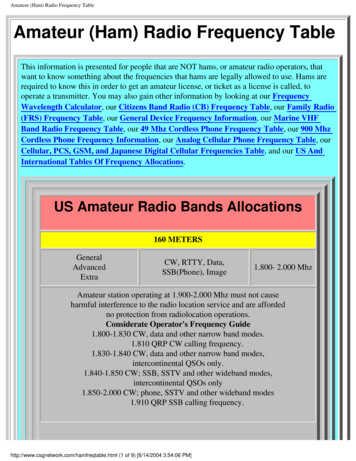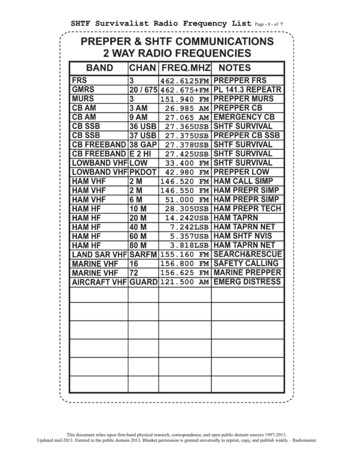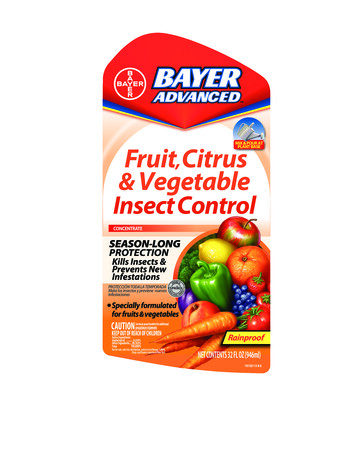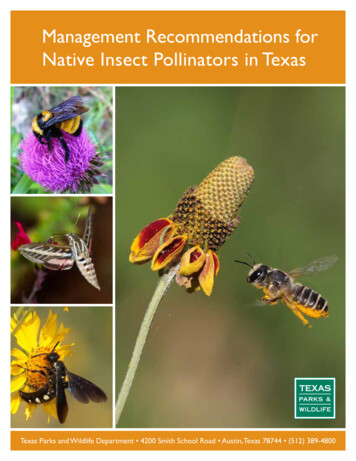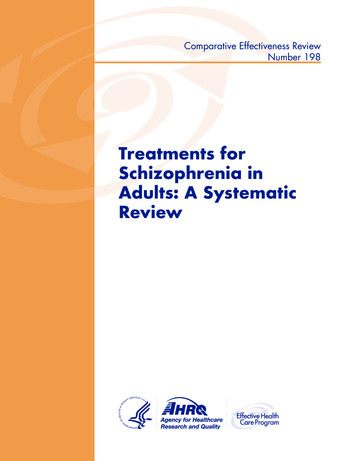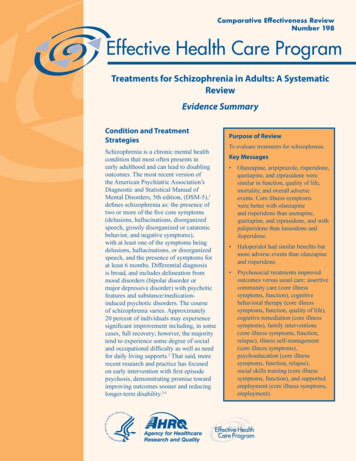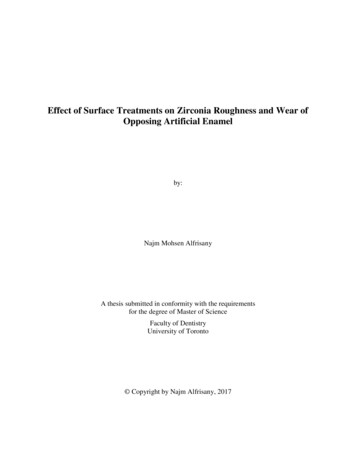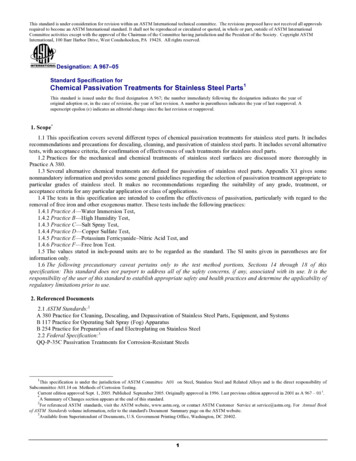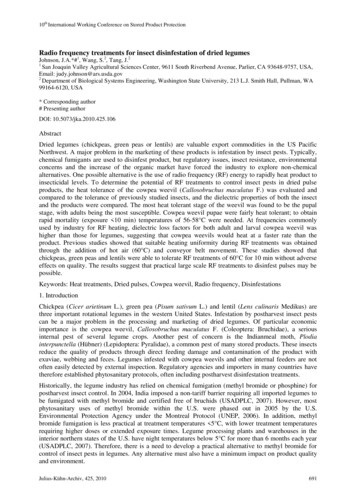
Transcription
10th International Working Conference on Stored Product ProtectionRadio frequency treatments for insect disinfestation of dried legumesJohnson, J.A.*#1, Wang, S.2, Tang, J.21San Joaquin Valley Agricultural Sciences Center, 9611 South Riverbend Avenue, Parlier, CA 93648-9757, USA,Email: judy.johnson@ars.usda.gov2Department of Biological Systems Engineering, Washington State University, 213 L.J. Smith Hall, Pullman, WA99164-6120, USA* Corresponding author# Presenting authorDOI: 10.5073/jka.2010.425.106AbstractDried legumes (chickpeas, green peas or lentils) are valuable export commodities in the US PacificNorthwest. A major problem in the marketing of these products is infestation by insect pests. Typically,chemical fumigants are used to disinfest product, but regulatory issues, insect resistance, environmentalconcerns and the increase of the organic market have forced the industry to explore non-chemicalalternatives. One possible alternative is the use of radio frequency (RF) energy to rapidly heat product toinsecticidal levels. To determine the potential of RF treatments to control insect pests in dried pulseproducts, the heat tolerance of the cowpea weevil (Callosobruchus maculatus F.) was evaluated andcompared to the tolerance of previously studied insects, and the dielectric properties of both the insectand the products were compared. The most heat tolerant stage of the weevil was found to be the pupalstage, with adults being the most susceptible. Cowpea weevil pupae were fairly heat tolerant; to obtainrapid mortality (exposure 10 min) temperatures of 56-58 C were needed. At frequencies commonlyused by industry for RF heating, dielectric loss factors for both adult and larval cowpea weevil washigher than those for legumes, suggesting that cowpea weevils would heat at a faster rate than theproduct. Previous studies showed that suitable heating uniformity during RF treatments was obtainedthrough the addition of hot air (60 C) and conveyor belt movement. These studies showed thatchickpeas, green peas and lentils were able to tolerate RF treatments of 60 C for 10 min without adverseeffects on quality. The results suggest that practical large scale RF treatments to disinfest pulses may bepossible.Keywords: Heat treatments, Dried pulses, Cowpea weevil, Radio frequency, Disinfestations1. IntroductionChickpea (Cicer arietinum L.), green pea (Pisum sativum L.) and lentil (Lens culinaris Medikus) arethree important rotational legumes in the western United States. Infestation by postharvest insect pestscan be a major problem in the processing and marketing of dried legumes. Of particular economicimportance is the cowpea weevil, Callosobruchus maculatus F. (Coleoptera: Bruchidae), a seriousinternal pest of several legume crops. Another pest of concern is the Indianmeal moth, Plodiainterpunctella (Hübner) (Lepidoptera: Pyralidae), a common pest of many stored products. These insectsreduce the quality of products through direct feeding damage and contamination of the product withexuviae, webbing and feces. Legumes infested with cowpea weevils and other internal feeders are notoften easily detected by external inspection. Regulatory agencies and importers in many countries havetherefore established phytosanitary protocols, often including postharvest disinfestation treatments.Historically, the legume industry has relied on chemical fumigation (methyl bromide or phosphine) forpostharvest insect control. In 2004, India imposed a non-tariff barrier requiring all imported legumes tobe fumigated with methyl bromide and certified free of bruchids (USADPLC, 2007). However, mostphytosanitary uses of methyl bromide within the U.S. were phased out in 2005 by the U.S.Environmental Protection Agency under the Montreal Protocol (UNEP, 2006). In addition, methylbromide fumigation is less practical at treatment temperatures 5 C, with lower treatment temperaturesrequiring higher doses or extended exposure times. Legume processing plants and warehouses in theinterior northern states of the U.S. have night temperatures below 5 C for more than 6 months each year(USADPLC, 2007). Therefore, there is a need to develop a practical alternative to methyl bromide forcontrol of insect pests in legumes. Any alternative must also have a minimum impact on product qualityand environment.Julius-Kühn-Archiv, 425, 2010691
10th International Working Conference on Stored Product ProtectionHeat treatment methods using hot air have been investigated extensively as non-chemical alternatives fordisinfesting stored commodities. However, it is difficult to accomplish disinfestation using conventionalhot air heating methods without causing deleterious effects to product quality (Armstrong, 1994), and theslow rate of heat transfer due to a high resistance of conduction within bulk materials results in extendedtreatment times (Evans et al., 1983). Low heating rates also may increase the thermotolerance of thetargeted insects (Beckett and Morton, 2003) by causing the induction of heat shock proteins in insects(Yin et al., 2006).Radio frequency (RF) energy offers the possibility of rapidly increasing temperatures within bulkmaterials. RF energy directly interacts with commodities containing polar molecules and charged ions togenerate heat volumetrically, significantly reducing treatment times when compared to conventionalheating methods. Many studies have explored the possibility of using RF energy to disinfest insect pests(Hallman and Sharp, 1994; Nelson, 1996). More recent studies demonstrated the potential of RFtreatments for industrial disinfestation of in-shell walnuts with acceptable product quality (Wang et al.,2007a, b). The demonstrated ability of RF treatments to disinfest low moisture products suggests thismethod for potential applications in dried legumes.The most important considerations in developing heat treatments using RF energy are thethermotolerance of targeted insects and treated products, and the heating uniformity of the product. In RFtreatments, heating uniformity is largely a function of the dielectric properties of the product and thedesign of the treatment. This paper presents information on the thermotolerance of target insects and thedielectric properties of products and target insects. The treatment effect on product quality and heatinguniformity of proposed RF treatments will also be discussed.2. Materials and methods2.1. Insect thermotoleranceThe relative heat tolerance of cowpea weevil stages was determined using a computer-controlled heatblock system designed by Washington State University (Ikediala et al., 2000; Wang et al., 2002). Testinsects were from a culture of cowpea weevils maintained at the San Joaquin Valley AgriculturalResearch Center, Parlier CA, on black-eyed peas, Vigna unguiculata (L.), at 28 0.5 C and aphotoperiod of 14:10 (L:D) h. Cowpea weevils were treated in mung beans, Vigna radiata (L.) Wilczek,a small legume that fit within the heat block and provided relatively rapid heat transfer. Adult cowpeaweevils were allowed to oviposit on clean mung beans for 24 h. Infested mung beans were held underrearing conditions and treated 2, 7, 15, and 21 d after infestation when developing cowpea weevils werein the egg, young larval, old larval and pupal stage, respectively. All stages were treated at 50 C for 50,100 and 150 min and 54 C for 7, 14, and 21 min. A second series of tests treated old larvae and pupae at54 C for 12, 16 and 20 min, and 56 C for 5, 8 and 11 min. All infested mung beans were held for adultemergence at rearing conditions. Emerging adults were counted and treatment survival estimated bycomparing emergence from treated beans with emergence from untreated controls. About 100 adultweevils in flat nylon screen bags were also treated at the above temperature/time combinations. Adultmortality was evaluated 24 h after treatment. When adults proved to be much less tolerant than theimmature stages, adults were also treated at a series of less extreme temperature-time combinations. Forall experiments each treatment was replicated three times.Preliminary estimates for the thermal tolerance of cowpea weevil were made for both the most tolerantimmature cowpea weevil stage (as determined above) and cowpea weevil adults. Thermal death time(TDT) curves based on the observed minimum exposure time that resulted in 100% mortality werecompared with those previously determined for Indianmeal moth, red flour beetle, Tribolium castaneum(Herbst) (Coleoptera: Tenebrionidae) and navel orangeworm, Amyelois transitella (Walker)(Lepidoptera: Pyralidae) in Johnson et al. (2003), Johnson et al. (2004), and Wang et al. (2002),respectively.2.2. Dielectric property measurementsImmature stages (late larvae and pupae) were dissected from black-eyed peas, while adult weevils werecollected from laboratory cultures. Both immature stages and adults were killed and stored at -20 C untilthey could be shipped to Washington State University for measurement. Dielectric measurements ofcowpea weevils were made using the open-ended coaxial probe technique with an impedence analyzer692Julius-Kühn-Archiv, 425, 2010
10th International Working Conference on Stored Product Protection(model 4291B, Hewlett-Packard, Santa Clara, CA, USA) over a frequency range of 10-1800 MHz (Wanget al., 2003). Measurements of the dielectric constant (ε ') and loss factor (ε ") were made at 20, 30, 40,50 and 60 C. Insect and legume moisture contents were determined on wet basis in aluminium moisturedishes in a vacuum oven (ADP-31, Yamato Scientific America Inc., Santa Clara, CA, USA) at 130 ºC forone hour (AOAC, 2002).The dielectric properties were compared to similar values obtained forIndianmeal moth (Wang et al., 2003). Of the four legumes previously studied (chickpea, green pea, lentiland soybean) in Guo et al. (2010), lentils were chosen as a representative legume for comparingdielectric properties.3. Results3.1. Insect thermotoleranceThe survival of cowpea weevil eggs, young larvae, old larvae and pupae exposed to 50 and 54 C by theheat block method is given in Figure 1. Eggs and young larvae were consistently the least tolerant to thetreatment in the heat block, while old larvae and pupae were the most tolerant. Complete mortalityoccurred in all adult cowpea weevil exposed to the temperature-time treatments in Figure 1.Figure 1Mortality of immature stages of the cowpea weevil at 50 C for 50, 100 and 150 min, and 54 C for 7, 14and 21 min.The results of further tests with old larvae and pupae at 54 and 56 C are given in Figure 2. Mortality ofold larvae was consistently higher than that for pupae. Based on these results, pupae were selected as themost tolerant cowpea weevil stage for more detailed thermal death studies. Preliminary results from thesestudies, given in Figure 3, show that cowpea weevil pupae are quite temperature tolerant when comparedto navel orangeworm, Indianmeal moth and red flour beetle. Figure 3 also shows that cowpea weeviladults, the least tolerant of the cowpea weevil stages using the heat block method, were also moretolerant than all the other insects previously tested.Julius-Kühn-Archiv, 425, 2010693
10th International Working Conference on Stored Product ProtectionFigure 2Mortality of cowpea weevil older larvae and pupae at 54 C for 12, 16 and 20 min, and 56 C for 5, 8and 11 min.Figure 3Thermal death time curves for cowpea weevil pupae and adults, navel orangeworm larvae, Indianmealmoth larvae and red flour beetle larvae.3.2. Dielectric property measurementsFigure 4 shows dielectric constant (ε′) and dielectric loss (ε″) for cowpea weevil immature stages,cowpea weevil adults, Indianmeal moth larvae and lentil (8% m.c.) as a function of frequency at 20 C.The ε′ and ε″ for both cowpea weevil immature stages (larvae and pupae) and adults were comparable tothose found for Indianmeal moth larvae (Wang et al., 2003). Both ε′ and ε″ for all insect stages werehigher than those for lentil due to the higher moisture (70.8%) of insects. This was consistent for alltemperatures tested. Figure 5 shows the effect of temperature on dielectric loss for cowpea weevilimmature stages and lentil at two different moisture contents (8 and 22%). The difference between thecowpea weevils and the product increased with increasing temperature. These results suggest that bothcowpea weevils and Indianmeal moth would heat at a faster rate than the product.694Julius-Kühn-Archiv, 425, 2010
10th International Working Conference on Stored Product ProtectionFigure 4Frequency dependence of the dielectric constant (ε′) and loss (ε″) for cowpea weevil immature stages(large larvae and pupae), adults, Indianmeal moth larvae and lentil (8% m.c.) at 20 C.Figure 5Temperature dependence of dielectric loss (ε″) at 27 MHz for cowpea weevil immature stages (largelarvae and pupae) and lentil at 8 and 22% m.c.4. DiscussionThe cowpea weevil is the first internal seed feeding insect to be tested using the heat block systemdesigned by Washington State University. Because of the carefully controlled and rapid heating ratesobtained with the heating block system, it has proven a valuable tool in determining thermal deathkinetics for several target insect pests in previous radio frequency feasibility studies (Wang et al., 2002;Johnson et al., 2003, 2004). However, there are some difficulties inherent in using this method on aninternal seed feeder. Dissecting the necessary number of test insects without causing extreme controlmortality was difficult, so test insects were treated within small mung bean to minimize the effect ofinsulation by the bean. Because test insects were treated in bean, it was difficult to be certain of the exactnumber of insects and stage being treated, resulting in sometimes variable results.The current study indicates that the pupal stage is the most heat tolerant stage of the cowpea weevil.However, care must be taken in applying this information. Eggs and adults were the least tolerant stagestested, and both these are external stages. It is difficult to compare these stages directly with the internallarval and pupal stages, due to the insulation of the bean. The heating rate experienced by internal stagesis much slower than that experienced by the external stages, but so is the cooling rate, making theestimation of the actual accumulative temperature effect very difficult. Because of this uncertainty, it isJulius-Kühn-Archiv, 425, 2010695
10th International Working Conference on Stored Product Protectionrecommended that studies to confirm the relative heat tolerance of cowpea weevil stages under RFheating be conducted before large-scale confirmatory studies using industrial RF units are attempted.Regardless of the relative tolerance of the internal stages, it is clear that the cowpea weevil is heattolerant when compared to other species, as the least tolerant cowpea weevil stage (adult) was moretolerant than any of the other species tested with the heat block. Protocols for RF treatments will likelyneed to raise products to 56 C or higher for more than 7 min to obtain adequate control of cowpeaweevil, and any such treatment should also control Indianmeal moth.The comparison of the dielectric properties of the target insects with those of the products indicates thatthe target insects should heat faster than the product when treated with RF energy. Theoreticaldifferential heating has been reported for several other products (Wang et al., 2003) and wasdemonstrated experimentally in almond (Wang and Tang, 2007). The occurrence of differential heatingimproves the likelihood of developing a successful RF treatment protocol, resulting in increased insectmortality at relatively low product temperatures that cause no harm to the product.Guo et al. (2010) calculated penetration depths of various legumes from their dielectric properties, notingthat penetration decreased as frequency increased. It was determined that the penetration depths in 27MHz industrial RF systems should provide sufficient throughput of product to be practical. Wang et al.(2010) suggested an RF treatment protocol for legumes using 27 MHz RF to rapidly heat product in a 10cm-deep bed to 60 C, then holding the product at 60 C for 10 min through the application of hot forcedair. Afterwards, the product would be reduced to a 1-cm-deep bed to allow for rapid cooling throughforced ambient air. In this treatment, the heating uniformity of the product was maximized by theaddition of 60 C forced hot air and movement along a conveyor belt. Mixing of the product betweensuccessive RF treatments did not improve heating uniformity, as had been found with RF treatments ofinshell walnut (Wang et al., 2007a). The results of the current study indicate that this treatment should besufficient to control cowpea weevil and Indianmeal moth, but additional tests are needed to confirm thetreatment protocol.The effect of the proposed treatment protocol on product quality was also examined by Wang et al.(2010). No significant differences in weight loss, moisture content, color or germination of chickpea,green pea or lentil were observed between RF treatments and unheated controls. RF treatments,therefore, should provide a practical, effective and environmentally friendly method for disinfestation ofpostharvest legumes while maintaining product quality. This paper represents the results of research only. Mention of a proprietary product or trade namedoes not constitute a recommendation or endorsement by the US Department of Agriculture.AcknowledgementsThis research was supported by grants from USDA-CSREES (2008-34103-19091), and WashingtonState University Agricultural Research Center. We wish to thank Karen Valero (USDA-ARS, Parlier,CA) for her technical assistance.ReferencesAOAC, 2002. Official Methods of Analysis. Association of Official Analytical Chemists, Gaithersburg, Maryland,USA.Armstrong, J.W., 1994. Heat and cold disinfestation treatments, In: Paull, R.E., Armstrong, J.W. (Eds), Insect Pestsand Fresh Horticultural Products: Treatments and Responses. CAB International, Wallingford, UK, pp. 103–119.Beckett, S.J., Morton, R., 2003. Mortality of Rhyzopertha dominica (F.) (Coleoptera: Bostrychidae) at graintemperatures ranging from 50 C to 60 C obtained at different rates of heating in a spouted bed. Journal ofStored Products Research 39, 313-332.Evans, D.E., Thorpe, G.R., Dermott, T., 1983. The disinfestations of wheat in a continuous-flow fluidized bed.Journal of Stored Products Research 19, 125-137.Guo, W., Wang, S., Tiwari, G., Johnson, J.A., Tang, J., 2010. Temperature and moisture dependent dielectricproperties of legume flours associated with dielectric heating. LWT – Food Science and Technology 43,193-201.Hallman, G.J., Sharp, J.L., 1994. Radio frequency heat treatments. In: Sharp, J.L., Hallman, G.J. (Eds), QuarantineTreatments for Pests of Food Plants. Westview Press, San Francisco, CA, USA, pp. 165-170.696Julius-Kühn-Archiv, 425, 2010
10th International Working Conference on Stored Product ProtectionIkediala, J.N., Tang, J., Wig, T., 2000. A heating block system for studying thermal death kinetics of insect pests.Transactions of the American Society of Agricultural Engineers 43, 351-358.Johnson, J.A., Valero, K.A., Wang, S., Tang, J., 2004. Thermal death kinetics of red flour beetle (Coleoptera:Tenebrionidae). Journal of Economic Entomology 97, 1868-1873.Johnson, J.A., Wang, S., Tang, J., 2003. Thermal death kinetics of fifth-instar Plodia interpunctella (Lepidoptera :Pyralidae). Journal of Economic Entomology 96, 519-524.Nelson, S.O., 1996. Review and assessment of radio-frequency and microwave energy for stored-grain insectcontrol. Transactions of the American Society of Agricultural Engineers 39, 1475-1484.UNEP, 2006. Handbook for the Montreal Protocol on Substances that Deplete the Ozone Layer. Seventh Ed.,United Nations Environmental Program Ozone Secretariat, Nairobi, Kenya,http://ozone.unep.o
DOI: 10.5073/jka.2010.425.106 Abstract Dried legumes (chickpeas, green peas or lentils) are valuable export commodities in the US Pacific Northwest. A major problem in the marketing of these products is infestation by insect pests. Typically, chemical fumigants are used to disinfest product, but regulatory issues, insect resistance, environmental
